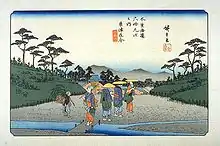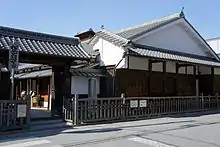Kusatsu-juku
Kusatsu-juku (草津宿, Kusatsu-juku) was the fifty-second of the fifty-three stations of the Tōkaidō as well as the sixty-eighth of the sixty-nine stations of the Nakasendō. It is located in the downtown area of the present-day city of Kusatsu, Shiga Prefecture, Japan.



History
Coming from Moriyama-juku, the borders of Kusatsu-juku started at the banks of the Kusatsu River to the present-day Miya-chō in Kusatsu. The famed ukiyo-e artist Hiroshige traveled through the post station using both the Tōkaidō and the Nakasendō in order to create woodblock prints.
In 1843, the post station of Kusatsu-juku had 2,351 residents and 586 buildings. Among the buildings, there were two honjin, two sub-honjin, and 72 hatago. Of the two honjin, one was constructed in 1635 and stood until 1870.[1] That honjin was later repaired and opened as a museum in 1996.[1]
Neighboring post towns
- Nakasendō
- Moriyama-juku - Kusatsu-juku - Ōtsu-juku
- Tōkaidō
- Ishibe-juku - Kusatsu-juku - Ōtsu-juku
References
![]() Media related to Kusatsu-juku at Wikimedia Commons
Media related to Kusatsu-juku at Wikimedia Commons
- Kusatsu-shi, Kusatsu-juku. City of Kusatsu. Accessed July 17, 2007.
